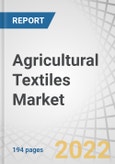The agricultural textiles market is projected to grow from USD 15.9 billion in 2023 to USD 20.2 billion by 2028, at a CAGR of 4.8% between 2023 and 2028. The key factor driving the growth of the market is increase in the area for greenhouse-protected cultivation.
Outdoor agriculture application segment is estimated to be the largest segment of the Agricultural Textiles market
Agricultural activities in uncontrolled environment such as orchards and fields are highly influenced by the environmental conditions. Fruits plantation such as apples require continuous attention to provide a good yield. In open environment especially in colder regions, colder temperatures and hail can lead to less yield, while harsh sunlight or heavy rainfall can easily destroy crops. Ground covers are highly effective in reducing the effects of UV rays on the soil hence preventing depletion of nutrients. The use of ground covers also help in regulating moisture and air flow in the soil. Sunscreens, anti-bird nets, anti-hail nets, mulch nets,and ground covers are commonly used textiles for outdoor agriculture. The textile used for outdoor purposes need high resistance to abrasion and resistance to weather condition. The use of agrotextile has been increasing and governments have been promoting the use by launching schemes.
Fishing nets application segment is forecasted to be the fastest-growing of the Agricultural Textiles market
Fishing nets have been used for a long time and are easily available in markets. However, they pose a great threat to the marine ecosystem and are responsible for most water pollution. With advanced technology, biodegradable fishing nets are being developed to solve this problem. Fishing nets have become a staple and cannot be replaced without an effective alternative. Asia Pacific is the world's largest fish producer, from both aquaculture and capture fishery sectors. The major countries in the region are China, Japan, and the Republic of Korea. The East China Sea, the Sea of Japan, and the Yellow Sea are among the most heavily exploited waters in the world. Fish consumption is high, and the countries of the sub-region are very active international traders. Hence, this will boost the demand for fishing nets in Asia Pacific.
Asia Pacific is the forecasted to be the fastest-growing Agricultural Textiles market during the forecast period
Asia Pacific is the largest agricultural textiles market globally. This is due to the increased demand for agricultural products, which is caused by shifting consumer tastes and an aging population. China is the dominant region in the agriculture textile market. There is a significant increase in the demand for agricultural textiles in other Asian economies, including India and South Korea. The demand for agricultural textiles is expected to increase in Indonesia, Malaysia, Singapore, and Australia & New Zealand due to the significant production and utilization of agricultural textiles expected in these countries between 2023 and 2028.
Breakdown of Primary Interviews:
- By Company Type: Tier 1 - 46%, Tier 2 - 36%, and Tier 3 - 18%
- By Designation: D Level - 27%, C Level - 18%, and Others - 55%
- By Region: Asia Pacific - 45%, North America - 18%, Europe - 9%, South America- 9%, and the Middle East & Africa - 9%
The key companies profiled in this report are Beaulieu Technical Textiles (Belgium), Belton industries (US), Hy-Tex (UK) Limited, Diatex SAS (France), and Garware Technical Fibres Limited (India).
Research Coverage:
The Agricultural Textiles market has been segmented based on fiber material (Nylon, Polyester, Polyethylene, Polypropylene, Natural Fiber, Biodegradable Synthetic Fibers, and Others), by fabric formation technology (Woven, Knitted, Nonwoven, and Others), by product type (Shade Nets/Cloths, Mulch Mats, Anti-hail Nets and Bird Protection Nets, Fishing Nets, and Others), by application (Outdoor agriculture and controlled-environment agriculture) and by Region (Asia Pacific, North America, Europe, South America, and Middle East & Africa).
This report provides insights on the following pointers:
- Analysis of key drivers, restraints, opportunities, and challenges influencing the growth of the agricultural textiles market.
- Product Development/Innovation: Detailed insight of upcoming technologies, research & development activities, and new product launch in the agricultural textiles market.
- Market Development: Comprehensive information about lucrative markets - the report analyses the agricultural textiles market across varied regions.
- Market Diversiification: Exclusive information about the new products & service untapped geographies, recent developments, and investments in agricultural textiles market.
- Competitive Assessment: In-depth assessment of market shares, growth strategies and service offerings of leading players like Beaulieu Technical Textiles (Belgium), Belton industries (US), Hy-Tex (UK) Limited, Diatex SAS (France), and Garware Technical Fibres Limited (India), among other in the agricultural textiles market.
Table of Contents
Companies Mentioned
- B&V Agro Irrigation Co.
- Badinotti Group S.P.A.
- Beaulieu Technical Textiles
- Belton Industries, Inc.
- Diatex Sas
- Drape Net Pty Ltd.
- Garware Technical Fibres Limited
- Helios Group S.R.L.
- Hunan Xinhai Co. Ltd.
- Hy-Tex (Uk) Ltd.
- Ludvig Svensson
- Memphis Net & Twine Co. Inc.
- Meyabond Industry & Trading (Beijing) Co. Ltd.
- Miller Net Company, Inc.
- Nagaura Net Co. Inc.
- Neo Corp International Ltd.
- Nitto Seimo Co. Ltd.
- Phormium
- Siang May Pte Ltd.
- Zhongshan Hongjun Nonwovens Co. Ltd.
Methodology

LOADING...
Table Information
| Report Attribute | Details |
|---|---|
| No. of Pages | 194 |
| Published | January 2022 |
| Forecast Period | 2023 - 2028 |
| Estimated Market Value ( USD | $ 15.9 Billion |
| Forecasted Market Value ( USD | $ 20.2 Billion |
| Compound Annual Growth Rate | 4.8% |
| Regions Covered | Global |
| No. of Companies Mentioned | 20 |









